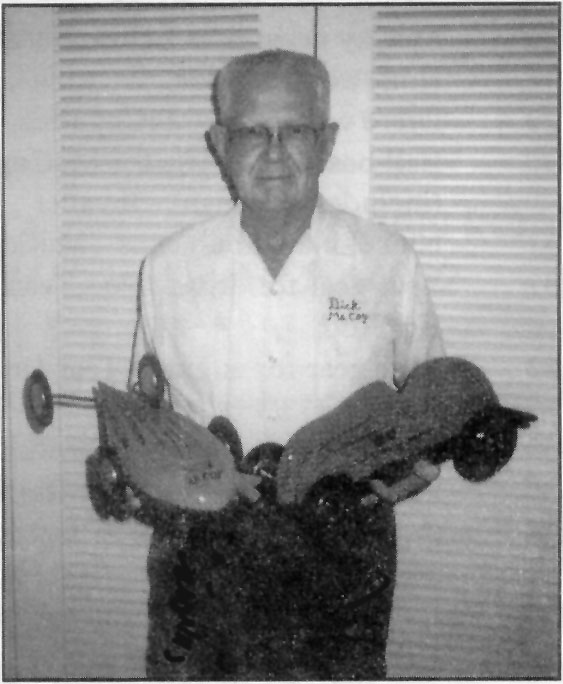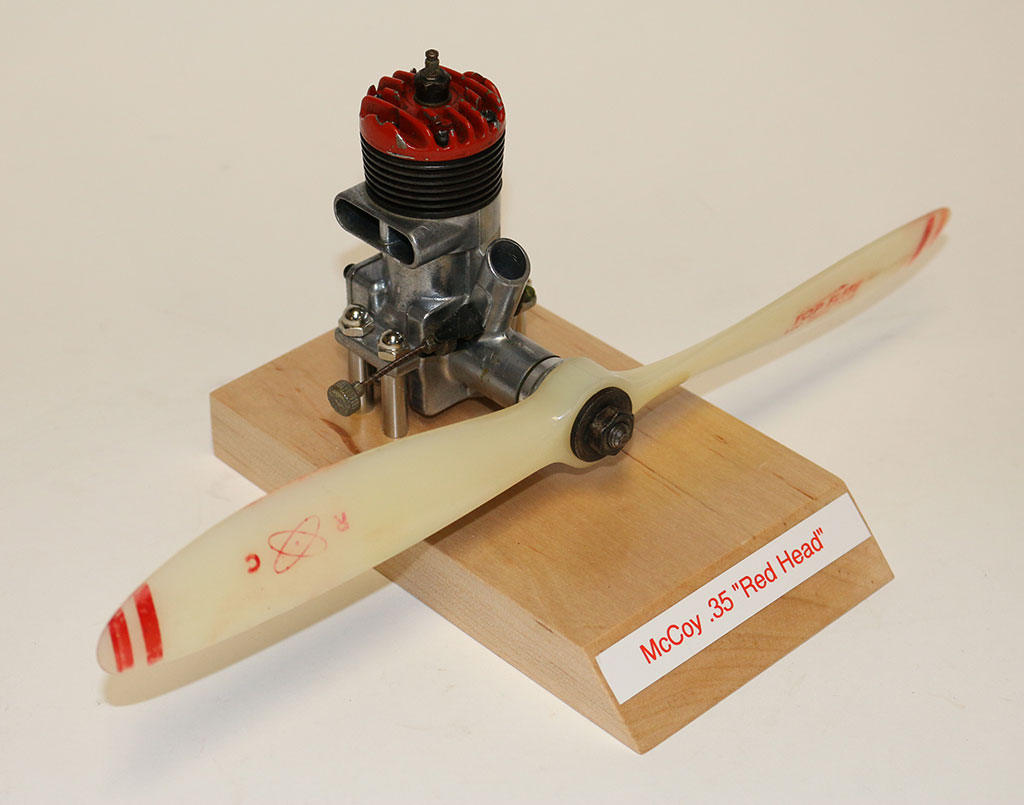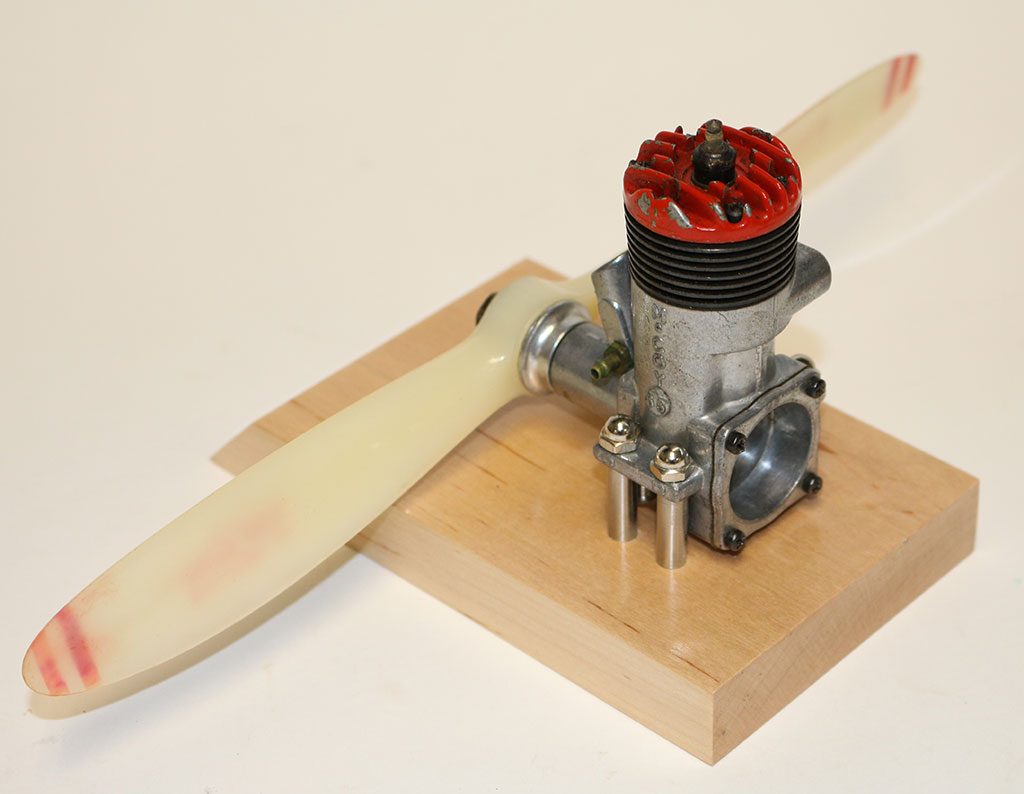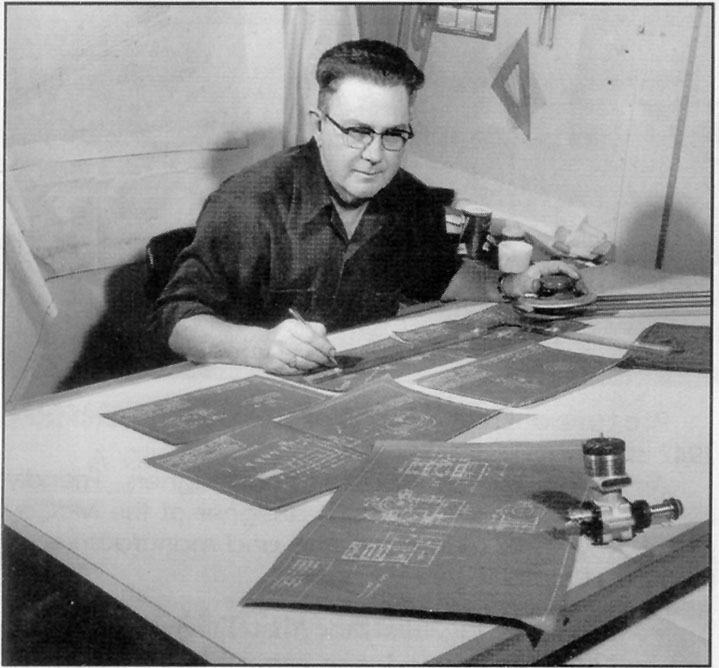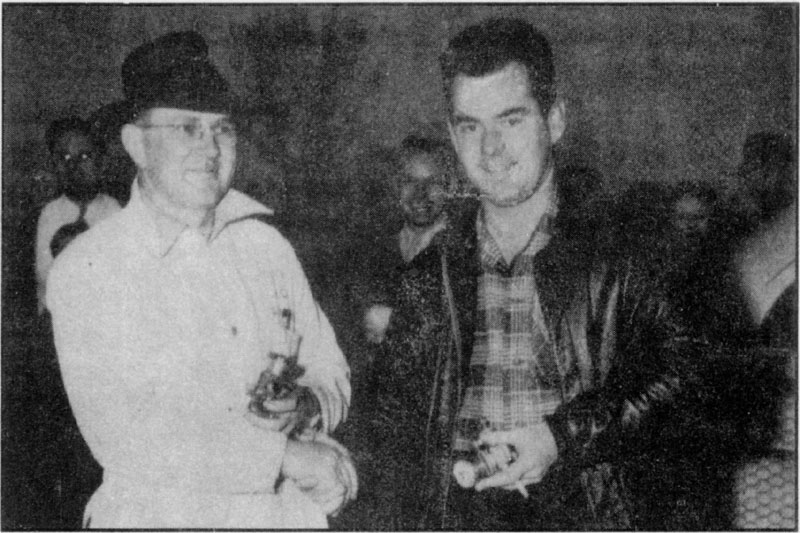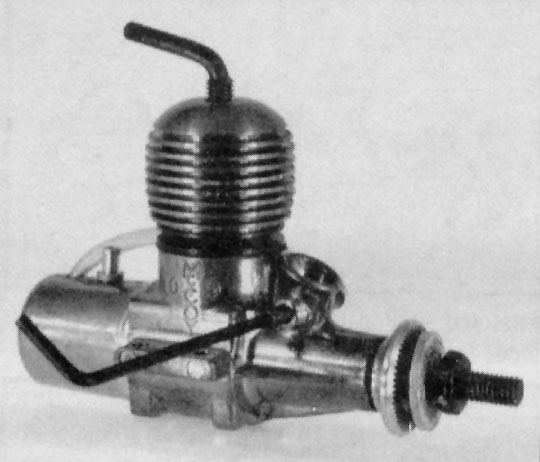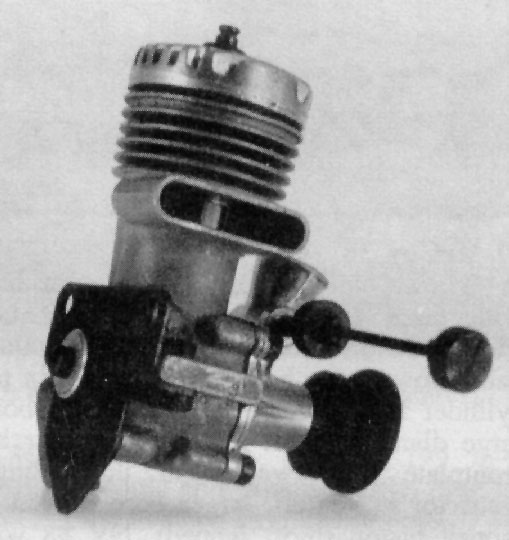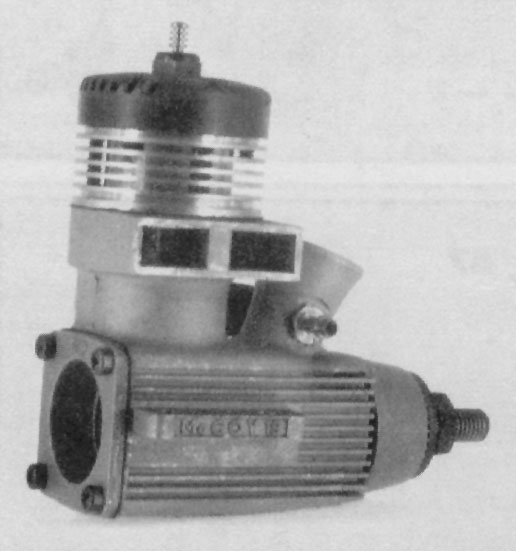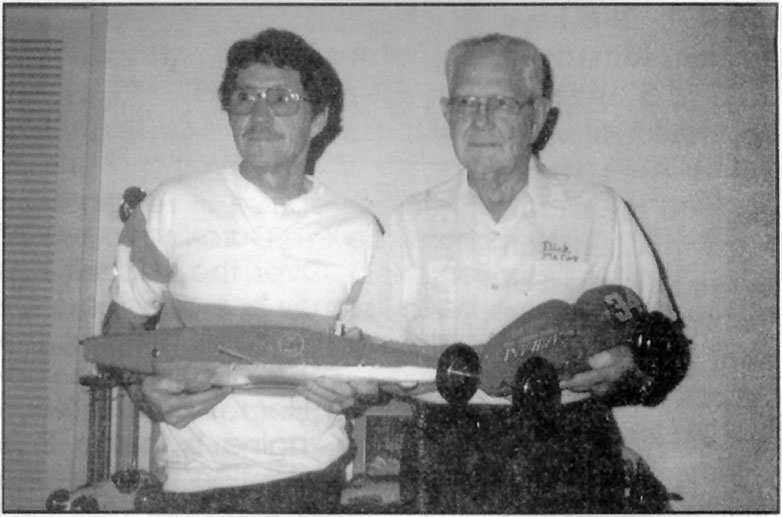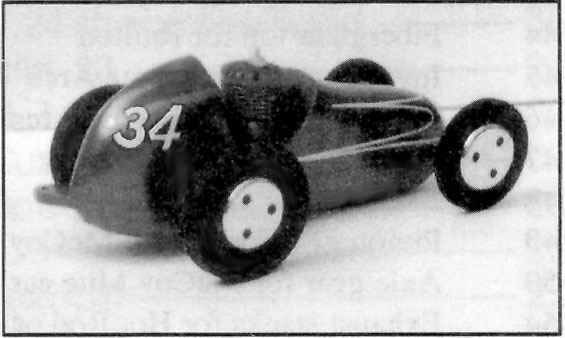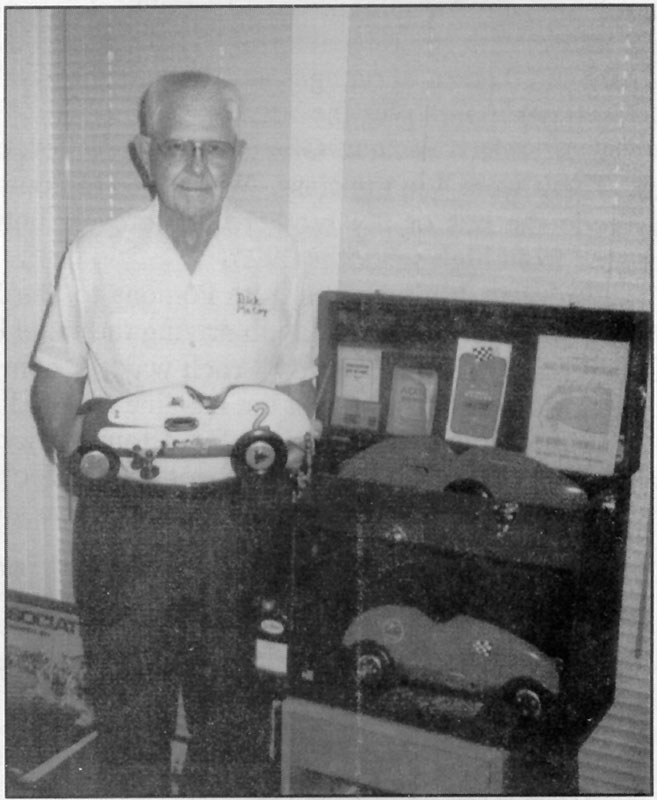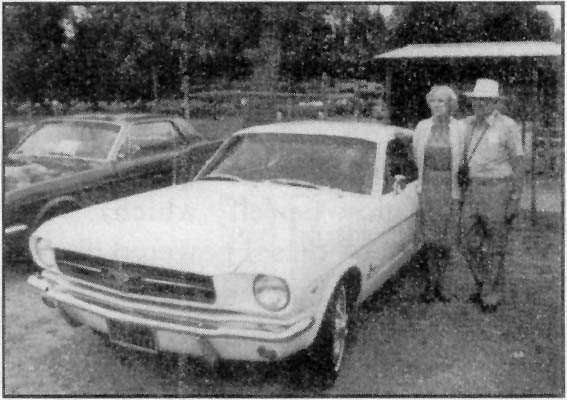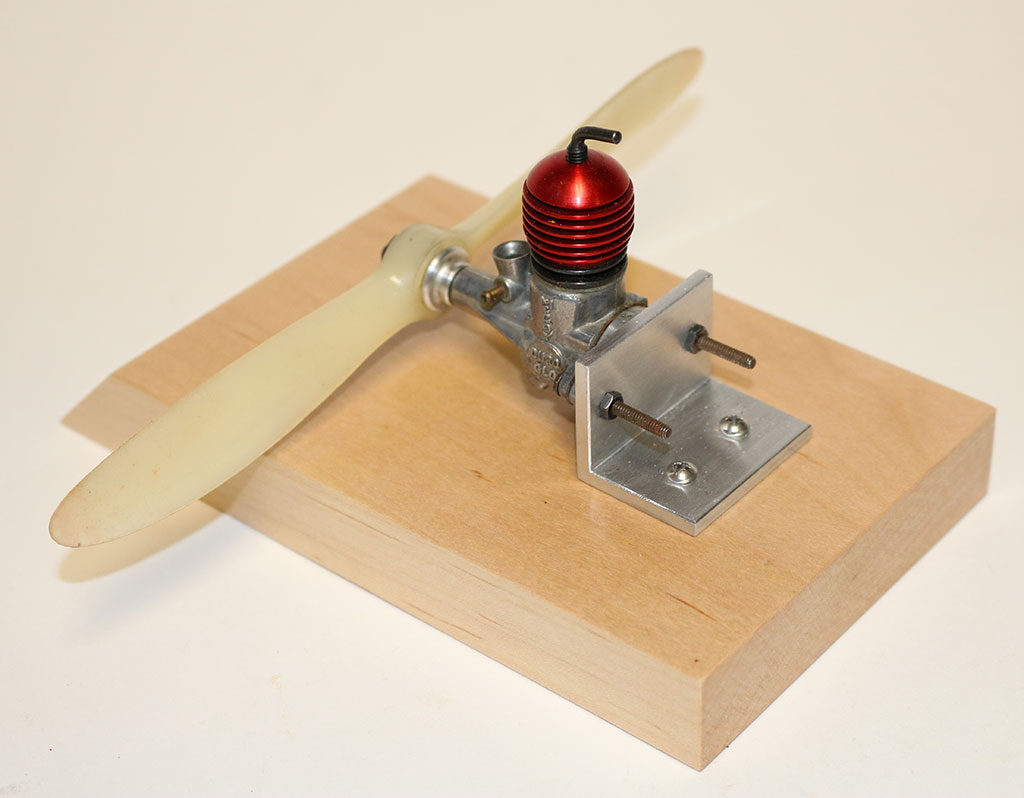June 9, 1907—December 30, 2005
An Early Start With Model Engines Leads to a Long Career
Dick is holding two original McCoy race cars: a 1946 Tear Drop, and a 1947 Invader cast in magnesium. Both were repainted, but the Invader was kept in its original red.
Introduction
Dick McCoy was one of the early pioneers of model engine design and construction. His special interest was in racing tethered model race cars. He adapted early model aircraft engine designs to suit the special needs of his race cars. Dick was good at getting the most out of an engine, and set many speed records. As a result, his engines became popular with both flyers and car racers.
Starting in the late 1930’s, Dick produced about 35 race car engines on his own. In 1945, he started having them made by Duro-Matic Products Co. in Hollywood. From 1953 to 1956, the engines were made by McCoy Products Co. in Culver City, before Dick turned production over to Testors in April, 1956. He still made many prototype McCoy engines for Testors during that time, but they handled all production and sales.
Along with his engines, Dick had produced a large line of model race car accessories. His mufflers were regarded as some of the quietest, high performance parts available. After 1983, Testors left the aircraft engine business to specialize in parts and accessories. Their glow plug line is still one of the best known in the world.
One of Dick’s more popular designs, this McCoy .35 Red Head engine is now part of our collection at the Miniature Engineering Craftsmanship Museum in Carlsbad, CA. The engine was donated by Tony Cina.
We regret to announce that Dick McCoy passed away on December 30, 2005 at the age of 98. He was a pioneering figure in the model engine world, and we thank him for his lasting contributions.
The following biographical information was originally published in The Engine Collector’s Journal, Issue 103, December 1992.
Dick at work in his design studio. In actuality, this photo was posed for a 1957 issue of the Testors Topics company newsletter. Dick is busy “drawing” the finished blueprints for a new engine. The McCoy 60 sitting on top of the drawing board was his latest design. The newsletter stated that the company was tooling up for a run of 5,000 Red Head 60’s.
Early Life
Dick McCoy was born in Indiana on June 9, 1907. At 11 years old, his family moved to Walnut, California into a house with no electricity or indoor plumbing. His father took care of 20 acres of oranges, and 15 acres of walnuts for $75.00 per month—plus the house.
Dick attended Walnut Grammar School for two years. There were only four children in his class. Eventually, his family moved to Pomona, where he rode the bus or his brother’s motorcycle until he graduated from high school in 1925.
His father was driving a bus from Pomona to San Dimas during the day, and Dick got a job driving the same bus until midnight. The fare was 10 cents each way. However, a company called Motor Transit bought the bus line, and Dick was laid off when they discovered he wasn’t 21. He found a job at Pomona Pumps for 40 cents an hour. Later, Dick went back to work for Motor Transit working on the busses at night.
An early McCoy engine that was made by Duro-Matic Products. This is an “MCCR” from 1945. It had .607 cubic inches displacement, and was fired via spark plug.
On July 19, 1929 Dick married his sweetheart, Fern. They were married for over 63 years until she passed away after a long illness on November 29, 1992. In 1932, their daughter Doris was born, followed by their sons—Carl in 1935, and Harold in 1937. The couple had 9 grandchildren and 13 great-grandchildren!
For some time, Dick worked with his father at a service station doing most of the repair work. After that, he went to work for Brodex Co. painting packing house equipment. There was a big freeze, which meant there was no fruit to pack, so he was soon laid off. In 1937, Dick went to work for Louds Machine Works running a lathe and making parts for oil well equipment.
In 1942, Dick took on an extra job in Pomona teaching men and women machine work for the war effort. He put in three hours each night at $2.50 an hour, and was getting paid .75 cents an hour at Louds.
It was during this time that Dick began designing and building engines and race cars. He had tried model airplanes; however, his only model, built in 1939 and powered with an Ohlsson 23, was a disaster. So Dick began devoting all of his time to cars. He ran many of the engines and cars of that era, but felt that none of them were actually designed solely as race car engines.
Also from 1954, this is another McCoy 9 engine, but with glow plug ignition. The engine pictured is equipped with an accessory radial mount plate, and came with a fuel tank when originally sold.
Building His Own Race Cars and Engines
By 1942, Dick had an engine and car of his own design. It ran well, and actually set records in the quarter and half-mile races. He also won first place in the quarter-mile, half-mile, and one-mile national races held in Detroit in July of 1942.
The success caused other enthusiasts to gravitate to his engines. In turn, those people also started winning races. Around 35 of these car engines were built. The .60 cubic inch engines were very close in appearance to those produced by Duro-Matic. Eventually, Dick signed a contract with Mr. Fred Schott of Duro-Matic in Hollywood to manufacture McCoy engines and cars.
Duro-Matic began production shortly after the Armistice. Dick designed and tested for them, and also for Testors (after Duro-Matic became a subsidiary) for some 35 years. He also held 16 patents on various features of the McCoy engines and cars.
In 1953, Dick’s two sons, Carl and Harold, started making a few parts for Louds (and two other companies) in a small basement machine shop at home. They worked under the name of C&H Products. Carl graduated from high school in 1954, and Harold in 1956, and they both went into the Navy for two years.
This McCoy .35 Red Head engine was rebuilt by Greg Davis. Ken Burdick wrote an article on Greg’s rebuild of the famous McCoy engine. It was written for Flying Lines, the newsletter for the Northwest Control-Line Model Aviation group. (Photo courtesy of Ken Burdick.)
After almost 20 years with Louds, Dick decided to retire and continue running the small shop that the boys had started. While Dick was at Louds, he had become the Chief Inspector with some 50 inspectors under him. They built parts for several different aircraft companies, including the landing gear for the DC 10.
At some point, Dick hired his son-in-law, and they ran the shop until Carl and Harold got out of the Navy. The family business was incorporated under the name of C&H, Inc. The business grew to about eight employees, and in 1964 they started making parts for model engines, cars and a new venture—glow plugs.
In 1972, they bought three 2,000 square foot buildings. They moved the business into one of them, and operated there until 1983, when they sold the aircraft portion of the business. Their main business turned to engine parts, and they maintained a reputation as one of the largest manufacturers of glow plugs in the world.
In 1972, Dick started sponsoring R/C car races. He held his 20th annual race on June 9, 1992 in Las Vegas, Nevada.
One former employee, Dan Neuenschwander, worked for Dick McCoy and his sons between 1979-1980. Dan was a machine operator. He noted that, “All three of them were great to work for, and Dick had a twinkle in his eye when something worked just right. They gave me my first real job in the path of my manufacturing career.” Dan also noted that he learned a lot about production manufacturing from the McCoys.
Taken on January 24, 1993, this picture shows Dick holding an original 1948 Invader race car. The car on top of the toolbox was a one-of-a-kind original, and the last car that Dick ran on the track.
The engines shown on this page are just a few of the many variations that McCoy manufactured over the years. Depending on their intended use, head configurations, mounting bolt holes and locations, fuel tank, and case—the designs could vary quite a bit. Issue #103 of The Engine Collector’s Journal shows or describes over 100 variations of production McCoy engines, which have been cataloged by collectors.
Additionally, the Academy of Model Aeronautics has published a lengthy biography of Dick McCoy.

